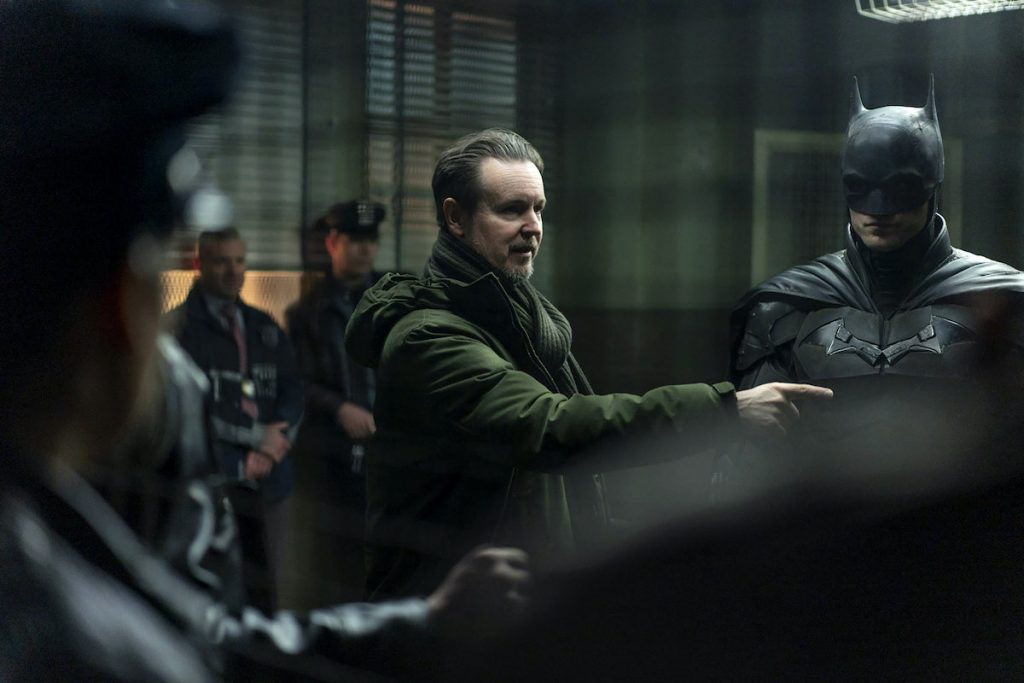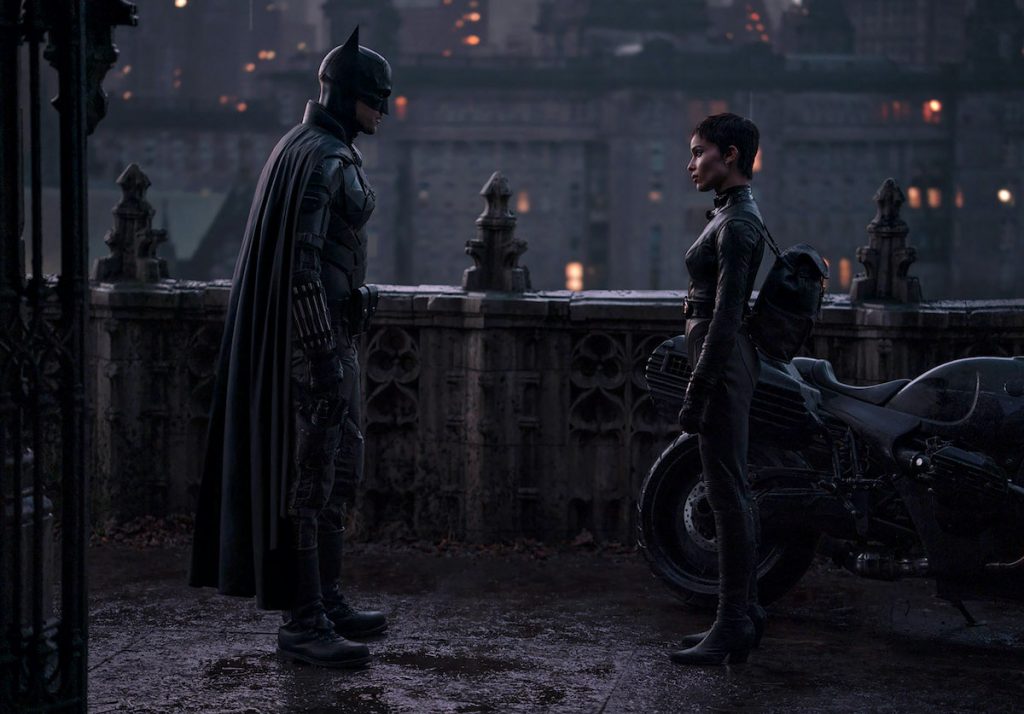When Ben Affleck, who had played Bruce Wayne/Batman in 2016’s Batman v Superman and the subsequent Justice League, decided not to go ahead with plans to direct and star in a solo Bat-film, Warner Bros. turned to Matt Reeves, who enlisted Clark to join him on the project.
Meanwhile, as questions swirled about who would replace Affleck under the cowl, Pattinson became fascinated by the idea of taking on the role.
What Pattinson didn’t know was that Reeves had begun writing The Batman with him in mind.
“Batman is an amazing myth that has endured for over 80 years,” says Reeves. “And it’s because of that crazy mix. There’s a part of it that is just simply cool, right? He looks cool. He’s got a cool car. He’s got all the stuff. He’s like James Bond, I guess, in a certain way, right? But there’s also something very relatable to the pain that he’s gone through.
“And so that, for me, was how you ground it — those aspects are part of the story. And this story emphasizes those things. This story pulls those things out. So that’s why I was so excited about Robert Pattinson because he’s such a wonderful actor. And I knew that he would be able to go on that search with me for the depth and complexity of this character. I mean, I knew he wasn’t going to play him straight ahead.
“In writing, from the beginning, I was imagining the character in my head. And I started watching movies of actors in the age range. And he just really kind of captivated me, and I started writing for him at a certain point. I had no idea if he ever would want to be in the movie.”

Reeves had spent many years resisting blockbusters, for fear of too many cooks and too many concessions to corporate demands. (“When the opportunity came to do Cloverfield, I said to J.J., I just want to understand why you want me to do this, because this fantastical part of it is not really the thing that I focus on,” says Reeves. “And he goes, ‘I know — you’re gonna make everything else real.”)
He worried that Pattinson might have a similar aversion to big-budget films.
“I’ve never auditioned for any comic book movies before,” Pattinson explains. “And at the time, even my agents thought it pretty out of character to just suddenly get fixated on Batman. And I didn’t even really know the status of the project.”
Around that time, Pattinson and Clark had a general meeting about potential collaborations, with no specific project in mind.
“We’re talking about 20 different things. And then he starts kind of saying, ‘So what’s going on with Batman?’” Clark says.
Adds Pattinson: “I had no idea that Matt had seen Good Time and thought, ‘I want to do a really dirty, dirty, slimy Batman.’”
“It was a kind of almost fated thing,” says Reeves. “Of course, at that point, we were still working on the script. And so there was nothing to share. But I met with him probably about eight months later, and I shared the script, and we just really connected.”
Bam Sock Pow
And then, despite all your planning, sometimes you lose control.
In March 2020, about two months into production, The Batman became one of countless films that shut down due to the then-mysterious coronavirus. It was one of the most scrutinized productions in the world, and one of the major films that Hollywood looked to as a test of how dramatically moviemaking might change because of the pandemic. Interest in The Batman was so high that Pattinson set off a fandom kerfluffle when he self-effacingly told GQ, in an interview conducted from quarantine, that he wasn’t actually working out that much for the role. “I think if you’re working out all the time, you’re part of the problem,” he told the magazine.
He was being dryly funny, not that anyone noticed.
“That really came back to haunt me. I just always think it’s really embarrassing to talk about how you’re working out,” he says, laughing about it now. “I think it’s like an English thing. Unless you are in the most unbelievable shape, where people are just genuinely curious, going, ‘How have you achieved, like, physical perfection?’ or whatever.”
He further clarifies: “You’re playing Batman. You have to work out.” He laughs again. “I think I was doing the interview when I was in lockdown, as well, in England. … I was in a lower gear of working out.”
It’s not the first time an offhand comment from Pattinson has been taken too seriously.
“It’s the same thing as saying in an interview when I was like 21 that I didn’t wash my hair,” he laughs. “It just sticks for 15 years.”
The attention was nothing compared to the headlines in September 2020, when shooting resumed, then had to pause again because of a positive COVID test for an unnamed member of the production.
The production kept everything very tight when filming resumed.
“It was like a military operation,” recalls Pattinson.
“We had earpieces in to have direction a lot of the time to kind of limit the amount of interactions. The most odd thing is that a lot of scenes had no one behind the camera, because we were trying — if it was already a setup, they’d just be remotely controlling it. Odd. Especially when you’re on a big set — just no one around at all. That took a lot of getting used to.”
Pattinson remembers it being very busy, intense and dark.
“We were basically in night shoots the whole time. I can’t even tell if people were there or not. And also your peripheral vision inside the cowl — I could hardly tell if there was anyone there or not.”

Kravitz felt the isolation as well.
“We all had to adjust to what that felt like — to be on set and to have to wear masks, to not see the crew’s faces, and not be able to just sit and chat with the crew and stuff. It became very impersonal in a way. So that was a little bit sad, because I love getting to know the crews I work with, and hanging out with them.
“I think we were all just happy to be there. But everyone was working really, really hard, and going home, and not able to go anywhere to let off steam or even go to a dinner, especially,” she says. “We were all supposed to be bubbling and stuff. I was very thankful to be there at all. But it was definitely bizarre.”
Wright remembers Reeves remaining “on point” throughout the COVID challenges — “and very passionate.”
“This process is a big behemoth that he was shouldering and in a really challenging environment,” Wright says. “But he was a fully masked, fully protected bull in pulling us through this thing.”
Stop
And while COVID compounded every problem, it wasn’t the only challenge to overcome.
Reeves recalls one scene, during the COVID stage of production, where some dialogue between Kravitz and Sarsgaard just didn’t gel.
“One of the things I think that I’ve learned is to never be afraid to just stop. Don’t get carried away with the energy of something. Because if you do, you might find yourself being carried down a current that’s totally wrong.
“We were shooting a scene with Peter Sarsgaard and Zoë, and it was something that was a beat we talked about in rehearsal. And Peter had said, ‘I’m not sure about this.’ And I was like, ‘No, I think it can work,’ and I had tracked in my head how it could work. And we started doing it, and it was clear, it didn’t work. And we were shooting it. I was like: We’re either going to shoot this, and I’ll be back here six months later, or something bad is gonna be in our movie. And I can’t allow that.
“And so I just said, OK, it’s not working, let’s stop.’ And then when we stopped, I just took out a piece of paper, and started trying to rework the dialogue. And we all were together, and I was trying to figure out where it wasn’t working. And I always think that that’s very important. That’s almost the scariest thing for some people to do — to stop when you’ve got, like, 500 people going, ‘What’s next?’”
“I do remember that scene, and do feel like it wasn’t working,” says Kravitz. “And he didn’t give up. This is what I love about Matt, you know? We sat down and we figured it out. We sat down for a while. And we just looked at the scene and talked it over and kind of ripped it apart.
“It was a dialogue thing. It was a story thing. It wasn’t flowing, right? We had been shooting for a few hours. And so the fact that he was willing to just say, ‘OK, let’s just stop and start from scratch’ — and basically rewrite this scene — that’s the level of care.
“He’s like, ‘What’s the point? We’re here, we’re doing this, we’ve written the script, we’ve gotten the money, we’re here, we’re in COVID. Let’s get the scene, right, you know?’ ”
She adds: “It’s scary to sit down in the middle of shooting, and after shooting the scene for three hours, to stop and rip it apart. But he will do that.”
You need to stop, Reeves says, “to get that compass to function again.”
That’s probably the biggest lesson that I learned. The thing that enables me to stop is to have a level of an internal understanding enough to be able to have a compass. And so that’s what I’m always looking for, is how to find a way to do something that might be genre, and then finding a way to make it personal. And if I can find that, then I can do that story. And that’s why Batman was a perfect one for me.”
The Batman, directed by Matt Reeves, is scheduled to open in theaters on March 4, from Warner Bros. Photos by Jonathan Olley/DC Comics
